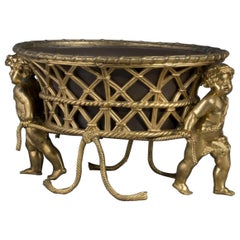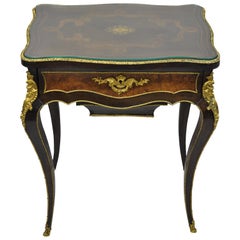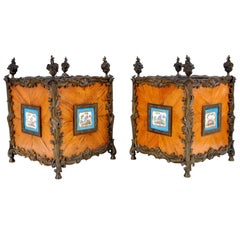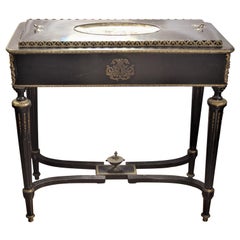Alphonse Giroux et Cie Furniture
2
to
1
1
2
2
2
2
1
2
2
2
1
1
1
2
2
3
107
46
32
28
Style: Louis XV
Creator: Alphonse Giroux et Cie
Louis XV Style Gilt-Bronze Jardinière by Maison Alphonse Giroux, French
By Alphonse Giroux et Cie
Located in Brighton, West Sussex
A Louis XV style gilt bronze Jardinière by Maison Alphonse Giroux.
Stamped 'Maison Alph GIROUX' a Paris'.
This elegant jardinière is in the form of an oval basket suspended between ropes by two finely cast putti. The jardinière retains its original painted metal liner.
Giroux (House of Alphonse Giroux et Cie)
Maison Giroux was founded by Francois-Simon-Alphonse Giroux in 1799 at 7 rue du Coq-Saint-Honoré, Paris. The store, specializing in small luxury goods and curiosities, expanded rapidly in the first half of the 19th century,
Francois oversaw the manufacture and design of small items of furniture until his death in 1848. He won the 'Prix de Rome' in 1825, and a silver medal at the Paris Exhibition of 1834.
Under the direction of Giroux's sons, Alphonse-Gustave and André, the company flourished and became by the late 1860s one of the most pre-eminent Parisian Maison de Haute Luxe (luxury stores).
In 1867, Ferdinand Duvinage...
Category
Mid-19th Century French Louis XV Antique Alphonse Giroux et Cie Furniture
Materials
Bronze
Maison Alphonse Giroux Paris Louis XV Ladies Work Table Sewing Vanity Stand
By Alphonse Giroux et Cie
Located in Philadelphia, PA
Maison Alphonse Giroux Paris French Louis XV style ladies work table sewing vanity stand. Item features shaped glass top, signed "Alph. Gi...
Category
19th Century French Louis XV Antique Alphonse Giroux et Cie Furniture
Materials
Bronze
Related Items
Antique French Louis XV Tulipwood and Sèvres Porcelain Jardinières, circa 1870
Located in Portland, OR
Pair of antique French Louis XV Tulipwood and Sèvres Porcelain jardinières / Planters, circa 1870. The planters having bronze flame finials and Rococo gilded bronze mounts, each side...
Category
Late 19th Century French Louis XV Antique Alphonse Giroux et Cie Furniture
Materials
Ormolu
H 14 in W 10.5 in D 10.5 in
Antique French Louis XVI Styled Ebonized Jardinière Table with Inset Plaque Top
Located in Hamilton, Ontario
This antique jardinière table is unmarked, but presumed to have been made in England or France is circa 1890 in a Louis XVI style. The table is composed of wood which has been painte...
Category
Late 19th Century French Louis XVI Antique Alphonse Giroux et Cie Furniture
Materials
Brass
H 33 in W 34.25 in D 17 in
19th Century Louis XV Style Jardinière or Plant Stand
By Manufacture Nationale de Sèvres
Located in Winter Park, FL
A 19th century French Louis XV style Rococo bronze mounted jardinière, or planter, on a pedestal stand. Kingwood marquetry veneer retains the old French polish finish. Decorated with...
Category
19th Century French Rococo Antique Alphonse Giroux et Cie Furniture
Materials
Bronze
Chinese Enamel and French Gilt Bronze Chinoiserie Jardinière
Located in London, GB
Chinese enamel and French gilt bronze Chinoiserie jardinière
The enamel Chinese and the gilt bronze French, 19th century
Measures: Height 40cm, width 53cm, depth 30cm.
This Chin...
Category
19th Century French Chinoiserie Antique Alphonse Giroux et Cie Furniture
Materials
Bronze, Enamel, Ormolu
Early 19th Century, French Louis XV Carved Painted & Gilt Bombe Floor Jardinière
Located in Dallas, TX
Decorate an atrium or indoor patio with plants in this elegant antique planter. Crafted in France, circa 1820, the jardinière stands on escargot feet decorated with acanthus leaves at the shoulders. The bombe planter with serpentine sides, features hand carved scrolled motifs throughout including a large shell and foliage in high relief in the center, over the scalloped apron. The long planter...
Category
Early 19th Century French Antique Alphonse Giroux et Cie Furniture
Materials
Wood, Giltwood, Paint
H 14 in W 47 in D 14 in
19th C. French Charles X Restoration Period Sewing Stand Work Table
Located in Forney, TX
A scarce period Charles X (1818-1834) French Restoration mahogany travailleuse sewing (thread stand - side table - jewelry dressing table) with light, warm, beautifully aged patina.
Born in France in the early 19th century, almost certainly Parisian work, exquisitely hand-crafted, this exceptionally executed example features ornate gilt bronze ormolu mounts, escutcheons, and elaborate gilt metal trim. Having a highly figured light mahogany hinged lid top, lifting open to reveal a striking finished interior with divided compartments and original inset mirror plate. The conforming rectangular case fitted with a faux drawer front over a dovetailed drawer with sectioned interior. Elegantly rising on oval-shaped medial shelf stretcher-joined curvacious legs.
Dimensions (approx):
27" High, 20" Wide, 13.5" Deep
Stunning light almost blonde antique mahogany coloring and mellow warm tone, superb wood grain detail, and charming, beautifully aged patina over the whole. Great shape overall. Retaining original antique character marks, wear consistent with age and indicative of minimal use, nothing that detracts from the aesthetics or functionality, but only adds to the overall authenticity, refined elegant warmth, luxurious sophistication, and cozy unpretentious rustic elegance.
Delivered cleaned, hand waxed, polished French patina finish, ready for immediate use and generational enjoyment!
What is Charles X style:
The comte d’Artois – or Charles X - was the son of the dauphin Louis-Ferdinand de Franc and Marie-Josèphe de Saxe. He succeeded his two brothers Louis XVI and Louis XVIII and became the King of France in 1824. Thirty years after the French Revolution, he wanted to embody the return of monarchy and became the leader of the catholic party . As the previous kings, he was crowned in 1825 but he was soon overthrown by the revolution in July, 1830, called "Trois Glorieuses". He left then for England, Scotland, Prague and Istria where he died in 1836.
Charles X style lasted from 1818 to 1834 and happened during the Bourbon Restoration (French Restoration). This style did not replace totally the style of furniture from the French Empire but it was different from the formalism in the Napoleonic era, during which strictness and simplicity were inspired by Greco-Roman art. Indeed, artistic fields flourished. In terms of furniture, this renewal was suggested by the softening of shapes. Even though the simple aspect from the French Empire was still visible, shapes became curvier with volutes and arabesques. Another distinction is the loss of the massive aspect of furniture and the decrease of dimensions in order to decorate smaller appartments. Handling ability and comfort were key-words in the making of furniture. Apartments had essential elements such as chests of drawers, big rounded tables in the dining room, desks or secretaries, armoires and even dressing tables, comfortable fainting couches in the living room, small tables, pedestal tables, as well as gondola chairs. The wavy aspect of the latters certainly represent Charles X style the best.
One of the most emblematic features of this style is the use of bois clairs – light woods in warm blond tones - and indigenous woods that are varnished in order to highlight the grains. Bird's-eye maple, ash trees, plane trees, yew trees, beech trees, olive trees and cedar trees were most likely to be used. Indeed, at the beginning of the 19th century dark woods were hard to find. In 1806, the Napoleon’s Continental System was established in order to ruin the United Kingdom by preventing the country from any business with the rest of Europe. Therefore craftsmen had to find alternatives from mahogany which was the most commonly used material at this time. After 1815, the import of wood was even more difficult because of peace treaties and the European political situation, which contributed to the popularity of the bois clairs and indigenous woods. The furniture was often decorated with fine inlays made out of dark wood representing foliage, which contrasted with the veneer. Even though these patterns can look like bronze decorations from the Empire era, they were far more simple and did not represent any military or mythological attributes. On the tables, trays were sometimes made out of marble as in the French Empire, but it was often put aside and inlaid veneer, Verre Eglomisé – a type of glass with a mirror finish –, mirror or porcelain from Sèvres or Paris were more likely to be used.
Decorative elements from the Monarchy were highly appreciated again as they suggested luxury. Indeed, marquetry work was particularly fashionable - Boulle marquetry thrived around 1820 as the works of the Levasseur family can show. In the same way, draperies and trimmings referred to the monarchist splendour. Fabrics were often white – the traditional colour of the Bourbons – or light coloured as oppposed to the typical green from the Napoleonic era.
One of the most symbolic figures from this period of time might be Jean-Jacques Werner (1791-1849), a cabinetmaker who worked for prestigious clients such as the Duchesse de Berry who was Charles’s step-daughter. His works can be seen at the Musée des Arts Décoratifs and at the Grand Trianon in the Palace of Versailles. The duchess’s appartments situated at the pavillon de Marsan and at the Palais de Saint Cloud illustrate Charles X style the best with furniture made out of bois clairs and ornamented with dark wood patterns or fine gold decorations.
Chales X style allows a transition between the sobriety of the Empire style and the abundant aspect of Louis-Philippe style. The gothic style started at this time through the "style à la cathédrale", inspired by religious architecture, which thrived from 1827 to 1830. Indeed, at the beginning of the 19th century, Romanticism put the spotlight on the Middle Ages. Cabinetmakers were not inspired by the medieval furniture but rather by architectural elements of churches and cathedrals. For instance the backs of chairs were decorated with arches shaped like rib and serration. In the same way, before Charles X abdicated, pieces of furniture were made out of dark woods – such as mahogany, which was used again in France – and were inlaid with light wood. Romanticism also influenced the layout of furniture in appartments to suggest movement through a mix of various styles, various shapes and various sizes, as opposed to the static aspect of Neoclassicism. The start of industrialisation and mechanisation also influenced this style as early technical developments led to the production of pieces of furniture in series.
Credit:
Marc Maison
Bibliography:
FANIEL Stéphane (Dir.), Le Dix-neuvième Siècle Français, Collection Connaissance des Arts, 1957, Hachette
SASSONE, Adriana Boidi, Furniture from Rococo to Art Deco, 2000, Evergreen
--
Extremely versatile:
As warm and attractive as it is useful, this remarkable antique table having the ideal size and small proportions for a variety of different uses, including as a side table, accent or occasional table, tall sofa...
Category
Early 19th Century French Charles X Antique Alphonse Giroux et Cie Furniture
Materials
Bronze, Ormolu
Vintage Singer Sewing Machine - Work Table
By Singer
Located in Cordova, SC
An antique oak sewing machine table with an iron base. As you can see in the first pictures it is of the table in the open position. The antique s...
Category
Early 20th Century American Arts and Crafts Alphonse Giroux et Cie Furniture
Materials
Iron
DISTRESSED ANTIQUE BURR WALNUT & HARDWOOD SEWiNG WORK TABLE CHESS BOARD TOP
Located in GB
Royal House Antiques
Royal House Antiques is delighted to offer for sale this original Victorian circa 1860-1880 Burr Walnut, work sewing table with Chessboard top and a beautifully...
Category
1860s English High Victorian Antique Alphonse Giroux et Cie Furniture
Materials
Hardwood, Walnut
H 27.96 in W 17.45 in D 17.13 in
Gilt-Bronze Mounted Metal Cloisonné Marquetry Jardinière by Ferdinand Duvinage
By Ferdinand Duvinage
Located in West Palm Beach, FL
A gilt-bronze mounted metal cloisonné marquetry jardinière by Ferdinand Duvinage, circa 1880, signed FDBte, the mounts signed Alph. Giroux Paris, me...
Category
1880s Antique Alphonse Giroux et Cie Furniture
Materials
Giltwood
Antique French Ledet et fils Louis XV Ladies Sewing Work Table Dressing Vanity
Located in Forney, TX
Refined country French elegance and sophistication at its finest, this Provincial Louis XV style lady's sewing stand work table or coiffeuse by Ledet et fils exudes refined grace and functionality.
Born in Bordeaux Region of Southwestern France in the mid-19th century, exceptionally executed in sophisticated King Louis Fifteenth (1715-1774) taste, hand-crafted of warm mellow solid mahogany, having a rectangular serpentine shaped hinged top opening to reveal the original flat mirror plate, over a removable divided tray, faux drawer front with wooden escutcheon, above a sewing / work bin, gently curved scalloped apron, all rising elegantly on long cabriole legs adorned with finely carved shell acanthus leaf knee ending in whorl feet, terminating on casters. circa 1850s
Signed, retaining the original ébéniste (cabinetmakers) makers mark to the underside, reading:
Ledet
Fab de Meubles
Bordeaux
Dimensions: (approx)
29.25" High, 24" Wide, 16.75" Deep
Versatile:
As warm and attractive as it is useful, having the ideal size and proportions for a variety of different uses, including as a side table, accent table, hall console, sofa table, bedside nightstand, rolling lamp...
Category
Mid-19th Century French Louis XV Antique Alphonse Giroux et Cie Furniture
Materials
Wood, Mahogany
H 29.25 in W 24 in D 16.75 in
Extendable French Louis XV Dining Table
Located in Los Angeles, CA
Elevate your dining experience with this French Louis XV dining table, meticulously crafted out of cherry wood. Our team of expert craftsm...
Category
1930s French Louis XV Vintage Alphonse Giroux et Cie Furniture
Materials
Wood, Cherry, Lacquer, Paint
Late 19th Century French Louis XVI Style Walnut Jardiniere, Planter, Zinc Liner
Located in Fayetteville, AR
This French Louis XVI style planter or jardiniere from the late nineteenth century is constructed of solid walnut and features its original removable zinc liner. The jardiniere stands on four turned legs joined by a lower shelf that provides additional display space. A handsome piece for use as an indoor plant stand...
Category
Late 19th Century French Louis XVI Antique Alphonse Giroux et Cie Furniture
Materials
Zinc
H 29.5 in W 26.5 in D 12 in
Alphonse Giroux Et Cie furniture for sale on 1stDibs.
Alphonse Giroux et Cie furniture are available for sale on 1stDibs. These distinctive items are frequently made of metal and are designed with extraordinary care. There are many options to choose from in our collection of Alphonse Giroux et Cie furniture, although brown editions of this piece are particularly popular. Many of the original furniture by Alphonse Giroux et Cie were created in the louis xv style in france during the 19th century. If you’re looking for additional options, many customers also consider furniture by Boin-Taburet, Lerolle Freres, and L'Escalier de Cristal. Prices for Alphonse Giroux et Cie furniture can differ depending upon size, time period and other attributes — on 1stDibs, these items begin at $450 and can go as high as $50,000, while a piece like these, on average, fetch $6,809.



